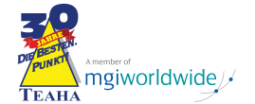Aid for newly established enterprises is eligible under the following conditions:
- a) enterprises eligible to receive aid are any innovative, unquoted small enterprise (including micro-enterprises) which has been registered no more than 5 years previously and which meets the following cumulative conditions:
(i) they have not taken over the activity of another enterprise, unless the turnover of the activity taken over represents less than 10% of the turnover of the eligible enterprise in the financial year preceding the takeover;
(ii)have not yet distributed profits;
(iii)have not taken over another undertaking or have not been formed by a merger, unless the turnover of the undertaking taken over represents less than 10% of the turnover of the eligible undertaking in the financial year preceding the acquisition or the turnover of the undertaking formed by a merger exceeds by less than 10% the combined turnover of the merging undertakings in the financial year preceding the merger.
In the case of eligible enterprises that are not subject to a registration obligation, the 5-year eligibility period can be considered to start from the moment when the enterprise in question either commences its economic activity or becomes liable to pay tax on its economic activity. Under this scheme only innovative start-ups are supported;
- b) by way of derogation from point (a), undertakings formed by the merger of undertakings eligible for aid under this paragraph shall also be regarded as eligible undertakings for a maximum period of five years from the date of registration of the oldest of the merging undertakings;
- c) no start-up aid shall be granted for projects supported under this scheme;
- d) the maximum amounts of aid for newly established enterprises will be calculated by applying the maximum allowable intensities set out in the Annex, without exceeding the maximum thresholds set out in Table 1.
Grants for research and development projects are eligible under the following conditions:
- a) the part of the research and development project for which aid is granted must fall completely within one or more of the following categories:
(i)industrial research;
(ii) experimental development;
(iii) feasibility studies;
- b) the eligible costs of research and development projects are allocated to a specific category of research and development and are as follows:
(i)personnel costs: researchers, technicians and other support staff, to the extent that they are employed on the project;
(ii)costs of instruments and equipment, to the extent that they are used in the project and for the duration of such use. Where such tools and equipment are not used throughout their life in the project, only depreciation costs corresponding to the life of the project, calculated on the basis of generally accepted accounting principles, shall be considered eligible;
(iii) costs of buildings and land, to the extent that they are used in the project and for the duration of such use. As regards buildings, only depreciation costs corresponding to the duration of the project, calculated on the basis of generally accepted accounting principles, shall be considered eligible. In the case of land, commercial transfer costs or capital costs actually incurred are eligible;
(iv)costs of contract research, knowledge and patents purchased or licensed from external sources on a fully competitive basis, and costs of consultancy and equivalent services used exclusively for the project;
(v)additional overheads and other operating costs, including the costs of materials, consumables and other similar products, incurred directly as a result of the project.
(vi)eligible costs for feasibility studies are the costs related to the study;
- c) the maximum amounts of aid for research and development shall be calculated by applying the maximum allowable aid intensities laid down in the Annex, without exceeding the maximum thresholds laid down in Table 1.
Grants for projects awarded a “mark of excellence” quality label are eligible under the following conditions:
- a) this funding may be awarded to SMEs for research and development projects and feasibility studies which have been awarded a “mark of excellence” quality label under the Horizon Europe programme;
- b) the eligible activities of the research and development project or feasibility study for which support is granted are those defined as eligible in the rules of the Horizon Europe programme, excluding activities which are not limited to experimental development activities;
- c) the categories, maximum amounts and methods of calculation of eligible costs of the aided research and development project or feasibility study are those defined as eligible in the rules of the Horizon Europe programme;
- d) the maximum amount of aid does not exceed EUR 2,5 million per SME, per research and development project or feasibility study;
- e) the total public funding granted to each research and development project or feasibility study does not exceed the funding rate established for that research and development project or feasibility study under the rules of the Horizon Europe programme.
Grants for teaming actions are eligible under the following conditions:
- a) such funding may be awarded for co-financed teaming actions involving at least two Member States and selected on the basis of the evaluation carried out and ranking drawn up by independent experts following transnational calls for proposals under the rules of the Horizon Europe programme;
- b) the eligible activities of the co-funded teaming action are those defined as eligible under the rules of the Horizon Europe programme. Excluded are activities which are not limited to experimental development activities;
- c) the categories, maximum amounts and methods of calculation of eligible costs are those defined as eligible in the rules of the Horizon Europe programme. In addition, investment costs in tangible and intangible assets related to projects are eligible;
- d) the total public funding granted does not exceed the funding rate established for teaming actions following the selection, ranking and evaluation carried out under the rules of the Horizon Europe Programme. In addition, for investments in tangible and intangible assets related to projects, the aid shall not exceed 70% of the investment costs;
- e) as regards aid for investments in infrastructure in the framework of teaming actions, the following additional conditions apply:
(i)where the infrastructure serves both economic and non-economic activities, the financing, costs and revenues relating to each type of activity are accounted for separately, based on consistently applied and objectively justifiable cost accounting principles;
(ii)the price charged for the operation or use of the infrastructure must correspond to a market price;
(iii)access to the infrastructure shall be open to a wide range of users and shall be granted on a transparent and non-discriminatory basis;
(iv) where infrastructure is publicly funded for both economic and non-economic activities, monitoring shall be ensured through the establishment of a clawback mechanism, which shall comply with applicable national legislation. The act establishing the clawback mechanism will be adopted within 6 months of the entry into force of the state aid measure.
Aid for investment in research infrastructures is eligible under the following conditions:
- a) this type of funding is granted for the construction or modernisation of research infrastructures carrying out economic activities;
- b) where a research infrastructure carries out both economic and non-economic activities, the funding, costs and revenues relating to each type of activity shall be taken into account separately on the basis of consistently applied and objectively justifiable cost accounting principles;
- c) the price charged for the operation or use of the infrastructure must correspond to a market price;
- d) access to the infrastructure is open to several users and is granted in a transparent and non-discriminatory manner;
- e) eligible costs are the costs of investment in tangible and intangible assets;
- f) the maximum intensity shall be 50% of the eligible costs;
- g) monitoring of economic/non-economic activities will be ensured through the establishment of a clawback mechanism that respects the national legislation in force. The act establishing the clawback mechanism will be adopted within 6 months of the entry into force of the State aid measure.
Innovation activities for SMEs are eligible under the following conditions:
- a) eligible costs are as follows:
(i) the costs of obtaining, validating and protecting patents and other intangible assets;
(ii) the costs of seconding highly qualified personnel from a research and knowledge dissemination organisation or a large enterprise carrying out research, development and innovation activities to a newly created position within the beneficiary enterprise without replacing other staff;
(iii) costs for innovation advisory and assistance services, including services provided by research and knowledge dissemination organisations, research infrastructures, testing and experimentation facilities;
- b) the aid intensity must not exceed 50% of the eligible costs;
- c) in the particular case of aid for innovation advisory services and for innovation support services, the aid intensity may be increased up to 100% of the eligible costs, provided that the total amount of aid for innovation advisory services and innovation support services does not exceed EUR 220 000 per undertaking over any period of three years.
Aid for process and organisational innovation is eligible under the following conditions:
- a) eligible costs are as follows:
(i) personnel costs;
(ii)costs of tools, equipment, buildings and land, to the extent that they are used in the project and for the duration of such use;
(iii)costs of contract research, knowledge and patents purchased or licensed from external sources on a fully competitive basis;
(iv)additional overheads and other operating costs, including the costs of materials, consumables and other similar products incurred directly as a result of the project;
- b) the maximum aid intensity is 50% of eligible costs.
The procedure for implementing and running the scheme is as follows:
- launching the call for projects;
- submission of the application for funding and accompanying documents by applicants through the MYSMIS computer system;
- registration of applications and accompanying documents by the scheme administrator;
- checking the administrative compliance of applications and accompanying documents. Only projects that pass this stage will be eligible for the next stage;
- technical-financial evaluation and selection of projects;
- the start of the contracting phase of the projects that have been admitted in the previous phase;
- drawing up and signing the financing contract;
- Submission of applications for reimbursement/pre-financing/payment accompanied by supporting documents;
- payment of the grant is made only on the basis of supporting documents, after verification of the expenditure;
- monitoring the implementation of the projects according to the contractual provisions and the Government Emergency Ordinance no. 77/2014 on national procedures in the field of state aid, as well as for amending and supplementing the Competition Law no. 21/1996, approved with amendments and additions by Law no. 20/2015, with subsequent amendments and additions.
- Legal basis:
MIPE Order no.3284/2023 on the approval of the State aid scheme for Research, Development and Innovation activities financed under priority 1. ”Support and promotion of an attractive and competitive RDI system in RO” of the Smart Growth and Digitization Programme and financial instruments

